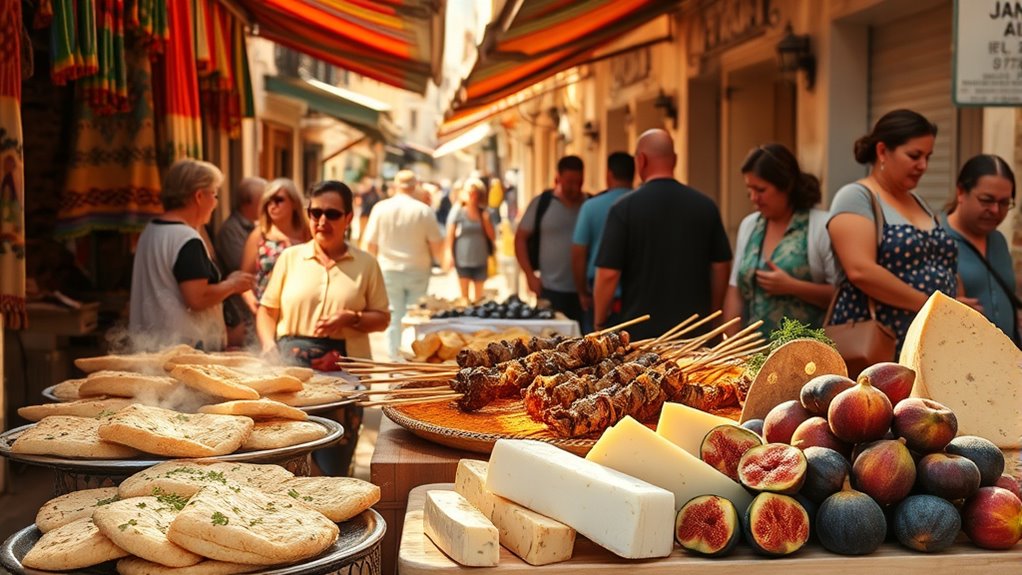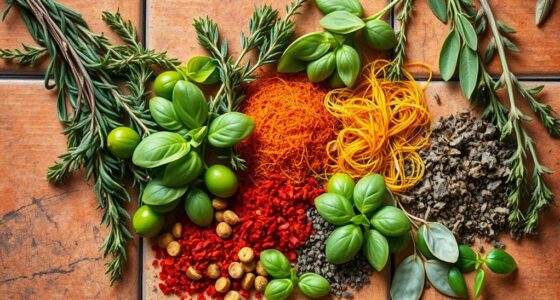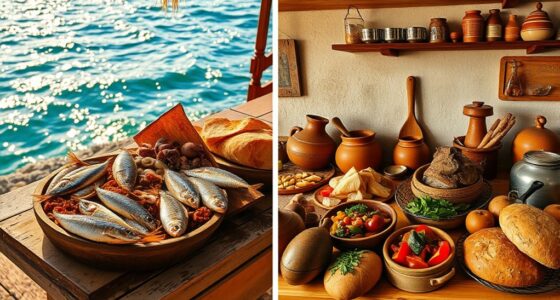Discover the vibrant world of Sardinian street food, where fresh seafood like clams and octopus mix with savory snacks, handmade pastas, and flavorful regional specialties. Savor treats like seadas and pistiddu, or enjoy iconic snacks such as pane carasau and culurgiones. Pair these bites with local wines, mirto, or sparkling Vermentino. To explore the island’s diverse flavors, ingredients, and culinary traditions, keep exploring what makes Sardinian street food truly unique.
Key Takeaways
- Sardinian street food includes savory snacks like pane carasau, cured meats, and seafood bites, reflecting coastal and regional flavors.
- Popular street desserts feature seadas, amaretti cookies, and honey-based pastries showcasing local artisanal sweets.
- Handmade pasta and dumplings such as culurgiones and lorighittas highlight regional craftsmanship and traditional techniques.
- Catalan influences are visible in dishes like lobster alla catalana and in culinary tools and ingredients used on the island.
- Local beverages like Mirto and Vermentino wine complement street food, emphasizing Sardinia’s rich beverage culture.
Classic Sardinian Seafood Delights

If you want to experience the true flavors of Sardinia’s coast, start with its classic seafood dishes. Fregola with clams offers toasted semolina pasta balls simmered in a fragrant seafood broth, highlighting Sardinia’s coastal richness. Spaghetti ai Ricci di Mare features fresh sea urchins, delivering a briny, creamy taste that captures the ocean’s essence. For a savory twist, try spaghetti with clams and bottarga—cured fish roe that adds a salty umami punch. Fregola with mussels presents another hearty option, simmered in a rich seafood sauce. Meanwhile, malloreddus, Sardinian gnocchetti, shine when paired with seafood, saffron, and local cheeses. These dishes showcase simple yet bold flavors, emphasizing freshness, high-quality ingredients, and Sardinia’s deep-rooted fishing traditions. Sardinian Blue Crab has also become an increasingly popular ingredient in these traditional dishes, blending modern culinary fusion with time-honored recipes. Incorporating authentic ingredients like Sardinian blue crab enhances the dishes’ freshness and highlights the island’s rich seafood heritage.
Traditional Savory Snacks and Appetizers

When exploring Sardinian street food, you’ll notice how savory snacks and appetizers showcase authentic flavors rooted in tradition. From cured cold cuts to vegetable-based starters, these dishes highlight regional ingredients and techniques. You’ll find that these popular staples reflect Sardinia’s rich culinary heritage and are perfect for sharing. Starters are vital in Sardinian cuisine, often prepared for special occasions like holidays, and serve as an introduction to the meal. Many of these dishes are crafted using traditional recipes, passed down through generations to preserve their distinctive taste and cultural significance.
Authentic Sardinian Flavors
Authentic Sardinian flavors in savory snacks and appetizers showcase a rich tapestry of pastoral, seafood, and vegetable influences. You’ll find hearty cheeses like pecorino, paired with wild boar ham, salami, and cold cuts, all served with traditional breads such as pane carasau and pistoccu for texture. Seafood options highlight octopus salads, lobster alla catalana, and fried anemones called orziadas, reflecting Sardinia’s coastal roots. Vegetable-forward snacks include shaved artichokes, stuffed eggplants, and grilled vegetables, emphasizing fresh, local produce. These flavors come together in simple yet robust dishes that embody Sardinia’s culinary heritage.
| Pastoral-Inspired | Seafood-Based |
|---|---|
| Pecorino cheese | Octopus salad |
| Wild boar ham | Lobster alla catalana |
| Pickled vegetables | Fried anemones (orziadas) |
| Traditional bread | Fish a la Scabecciu |
| Wild bird specialties | Fresh local seafood |
Popular Appetizer Staples
Traditional Sardinian appetizers showcase a variety of savory bites that highlight the island’s rich culinary heritage. You’ll find thin, crispy Pane Carasau, a staple bread used as a base for many dishes, and Pane Frattau, soaked in sheep broth and topped with tomato sauce, a flavorful agricultural-origin snack. Mustazzedu focaccia offers a distinctive texture and flavor, while modern street food features focaccia baskets and salads inside edible bread. Pizzetta slices provide quick, tasty bites perfect for on-the-go snacking. Cured meats like Pecorino Sardo and local salami are common, often paired with bread or focaccia. Seafood favorites include grated Bottarga, Sardinian caviar, and small fish-based bites, reflecting the island’s fishing traditions. These appetizers bring authentic flavors straight to your street-side experience. Pane Carasau is traditionally cooked collectively during family gatherings, emphasizing its cultural significance.
Handmade Dumplings and Pasta Specialties

In Sardinia, handmade dumplings and pasta specialties showcase centuries-old craftsmanship and regional pride. Lorighittas, unique to Morgongiori, are braided rings twisted by hand, dating back to the 16th century and once mentioned in royal reports. Culurgiones from Ogliastra are delicate dumplings filled with mashed potatoes, Pecorino Sardo, and mint, sealed with intricate folds. Ittiri’s Ciccioneddos resemble tiny gnocchi, traditionally made for weddings and special occasions. Usini’s Andarinos are spiral-shaped, crafted over textured boards to hold rich lamb ragù, reflecting labor-intensive techniques. These artisanal pastas highlight Sardinia’s agricultural roots, with ingredients like durum wheat, local cheeses, and herbs. Their creation involves skilled handwork passed down through generations, often reserved for celebrations and communal gatherings. The tradition of hand-braiding lorighittas is declining and is considered endangered by Slow Food’s Ark of Taste, making the preservation of these unique pasta methods even more important. Additionally, many of these pasta shapes are made using traditional techniques that have been maintained for centuries, emphasizing the importance of cultural preservation.
Regional Soup and Hearty Broths

Sardinian soups and broths are hearty, flavorful staples that reflect the island’s rich culinary heritage. When you try minestrone, you’ll notice the use of extra virgin olive oil, sweet potatoes, tomatoes, beans, and fregola pasta, creating a nourishing, umami-rich dish. This soup is often cooked slowly, with aromatics and tomato paste, then finished with fresh herbs, cheese, and a drizzle of olive oil. S’erbuzzu, another traditional soup, combines wild greens, beans, and sometimes pancetta, simmered for hours to develop deep flavors. Seafood soups feature mussels and clams cooked in fish or seawater-based broths, with fregula soaking up the rich broth and garnished with lemon zest and chives. These soups highlight Sardinia’s local produce and coastal ingredients, offering rustic comfort and nutritional benefits. Additionally, the use of fregola pasta in many of these soups showcases Sardinia’s unique regional ingredients and culinary traditions.
Unique Ingredients in Sardinian Street Food

Have you ever wondered what makes Sardinian street food stand out? It’s the unique ingredients that give these dishes their distinct flavors. Here are three key elements:
- Pecorino Sardo – A hard sheep’s milk cheese, aged for a bold, intense flavor, and used in dishes like culurgiones. Pecorino Sardo is also often grated over traditional pasta dishes, adding a sharp, savory note.
- Fennel seeds and wild fennel – These aromatic herbs season sausages and roasts, imparting a sweet, licorice-like aroma.
- Bottarga – Sardinian cured roe, grated over pasta or sliced as a savory snack, adding a rich, briny taste.
These ingredients, combined with regional herbs, spices, and pasta made from durum wheat semolina, create the authentic, memorable flavors of Sardinian street food.
Catalan and Maritime Influences on Local Cuisine

You’ll notice how Catalan culinary heritage shapes many local dishes, especially in Alghero, where history and culture blend seamlessly. Seafood and coastal flavors dominate street foods, reflecting Sardinia’s maritime connections and trade routes. These influences create a unique culinary landscape that combines Mediterranean spices, traditional recipes, and cultural exchanges. The region’s historical ties to Catalonia and Spain are also evident in the use of specific ingredients like bottarga and Vermentino wine, which are integral to local cuisine.
Catalan Culinary Heritage
Did you know that the culinary traditions of Alghero, a city in Sardinia, are deeply rooted in Catalan history and maritime trade? This influence is evident in language, architecture, and food. You’ll find Catalan words in local recipes and place names like Carrer del Bisbe, reflecting a lasting cultural imprint. Catalan trade routes introduced ingredients and techniques that shaped Sardinian cuisine. Medieval Catalonia’s influence extended to Sardinia via trade connections, which facilitated the exchange of culinary practices. Here are three key aspects: 1. Sardinian torrone, sharing roots with Catalan *turron de Alicante*, uses imported almonds and honey, symbolizing Iberian culinary influence. 2. Techniques like *picada* and *sofregit* crossed over, enriching Sardinian cooking methods. 3. Mediterranean spices such as saffron and cinnamon, traded through Catalan ports, became staples in local dishes, blending flavors across cultures. Additionally, the maritime trade routes established between Catalonia and Sardinia facilitated the exchange of not only ingredients but also culinary techniques that continue to influence local cuisine today.
Seafood and Coastal Flavors
What makes Sardinian coastal cuisine uniquely vibrant are the maritime influences deeply rooted in Catalan traditions and local fishing practices. You’ll find dishes like Aragosta alla catalana, where lobster is boiled and served with onion and tomato, reflecting Catalan roots. Octopus salad (Insalata di polpo) showcases fresh seafood with potatoes, celery, and parsley. Orziadas, fried anemones coated in flour, highlight regional marine ingredients. Fish a la Scabecciu, fried marinated fish, hails from Cagliari’s coastal cuisine. Spaghetti with sea urchin emphasizes seasonal, sustainable seafood. These dishes incorporate local ingredients and techniques, often using Vermentino wine, garlic, olive oil, and herbs. The use of sustainable seafood demonstrates a deep connection to environmental preservation and regional fishing practices.
Historical Cultural Exchanges
The rich culinary landscape of Sardinia is deeply shaped by its historical ties to Catalan and maritime powers, which introduced distinct flavors, ingredients, and cooking techniques. These influences are especially evident in Alghero, where Catalan language and customs persist, and local cuisine reflects traditional recipes like lobster dishes prepared with Catalan methods. Maritime trade also played a pivotal role, bringing spices, preserved foods, and pasta variants like fregula from Moorish and Mediterranean sources. Additionally, Sardinian culinary tools such as terracotta and copper cookware mirror Catalan and wider Mediterranean practices. These cultural exchanges are also reflected in the widespread use of almonds and saffron, ingredients that were traded along maritime routes and incorporated into local desserts and dishes. You’ll notice these influences in: 1. Catalan-style seafood recipes, especially in Alghero’s dishes. 2. Traditional baking techniques like pane Carasau’s double toasting. 3. Use of spices and preserved foods, rooted in maritime trade traditions.
Iconic Dishes From Sardinian Cities and Regions

Sardinia’s diverse regions each boast their own iconic street foods that reflect local traditions and ingredients. In Ogliastra and Barbagia, you’ll find culurgiones—hand-shaped dumplings filled with potato, pecorino, and mint, often served with tomato or meat sauce. Campidano is famous for malloreddus, ridged semolina gnocchi paired with fennel sausage and tomato ragù. Along the coast, fregola—toasted semolina pasta—shines in seafood stews with clams or mussels. Central and northern Sardinia serve pane carasau, a crisp flatbread, layered into pani frattau with broth, egg, and cheese. Coastal towns offer seafood specialties like lobster alla catalana, octopus salad, and fried sea anemones. Here’s a quick look at these dishes:
| Dish | Region |
|---|---|
| Culurgiones | Ogliastra & Barbagia |
| Malloreddus | Campidano |
| Fregola | Cagliari & Coastal Areas |
Sardinian cuisine is known for its use of local ingredients and traditional methods that have been preserved over centuries, making these regional specialties truly authentic.
Sweet Treats and Traditional Desserts

You’ll find that Sardinian sweets are rich with honeyed flavors and delicate pastries. From crispy amaretti to flaky seadas filled with cheese and citrus zest, each treat reflects local traditions. These desserts are perfect for experiencing the island’s sweet side and celebrating its festive spirit. Verina’s Pulas Pulas, a star-shaped pastry filled with ricotta and flavored with orange zest and saffron, exemplifies the region’s love for aromatic, honey-infused confections. Incorporating traditional baking techniques enhances their unique textures and flavors, making each bite a true taste of Sardinia.
Sweet Honeyed Delights
Sweet honeyed delights form a cherished part of Sardinian dessert traditions, blending rich flavors and local ingredients to create memorable treats. You’ll find honey, especially corbezzolo honey, adding a distinctive aroma and sweetness to these desserts. Sardinia’s sweets often incorporate almonds, orange peel, and sheep’s milk cheese, enhancing their flavor profiles. Papassinos are another popular treat, featuring a mixture of almonds, walnuts, and raisins, often topped with a dusting of icing sugar. Here are some standout treats:
- Seadas – Fried pastries filled with lemon-scented cheese, topped with warm honey or sugar.
- Arantzada – Orange peels soaked in honey and covered with almonds, often served at weddings.
- Sospiros – Small sugar, almond, and honey balls, usually coated with icing.
Each dessert reflects local ingredients and cultural traditions, making them a crucial part of Sardinian celebrations.
Classic Sardinian Pastries
Traditional Sardinian pastries showcase a rich variety of sweet treats and desserts rooted in local customs. You’ll find tiliccas, thin, crispy pastries from the northwest, traditionally made for All Saints Day. They come in shapes like horseshoes, hearts, or spirals, filled with sapa, cocoa, raisins, or almonds, offering a delicate crunch. Seadas, another local favorite, are flaky pastries filled with sheep’s cheese or ricotta, flavored with lemon or orange zest, then fried and drizzled with honey or sugar. Amaretti cookies, made from almonds and egg whites, are crispy and golden, often enjoyed during festivities. For special occasions like St. Anthony’s Day, pistiddu pastries filled with honey and mulled wine add aromatic richness. These pastries beautifully reflect Sardinia’s culinary traditions and festive spirit. Incorporating traditional baked goods, many of these desserts are crafted using age-old recipes that highlight the island’s artisanal baking techniques.
Popular Beverages and Local Liquors

Ever wondered what beverages best capture Sardinia’s vibrant spirit? You’ll find that local drinks are deeply rooted in tradition and perfect for any occasion. Here are three you should try:
- Mirto: The island’s emblematic liqueur, made from myrtle berries and leaves. It’s available in red (*Mirto rosso*) and white (*Mirto bianco*), offering complex flavors with hints of blueberry, juniper, and pine. Usually served cold as a digestif, Mirto symbolizes Sardinian hospitality and history.
- Wines: Sardinia’s robust reds like Cannonau and crisp whites like Vermentino reflect the island’s terroir. These wines are enjoyed with meals or in traditional cocktails, showcasing centuries of winemaking tradition.
- Summer Refreshers: Beer dominates hot days, while the Bicicletta cocktail, with Campari, wine, soda, and lemon, offers a cool, zesty escape. Exploring local beverages reveals how they embody the island’s cultural identity and history.
Must-Try Food Combinations and Pairings

Pairing Sardinian street food with local beverages amplifies the island’s vibrant flavors and cultural richness. For example, enjoy crispy pane carasau with a chilled Vermentino wine or a invigorating local beer. Hearty dishes like malloreddus with sausage benefit from a robust Cannonau red. Light seafood such as fregola with clams pairs beautifully with a sparkling Vermentino or a crisp white wine. For a flavorful contrast, try Pecorino Sardo cheese with a glass of Mirto, Sardinia’s traditional liqueur.
| Food Pairing | Beverage Choice |
|---|---|
| Culurgiones with tomato sauce | Red wine or local beer |
| Seafood stews with fregola | Vermentino or sparkling wine |
| Pecorino Sardo with Mirto | Sardinian liqueur |
Frequently Asked Questions
What Are the Best Local Street Food Spots in Sardinia?
You want to find the best local street food spots in Sardinia. Head to La Piadina del Pozzo for traditional piadina flatbreads, or visit Buns Homemade Burger for premium burgers. Explore San Benedetto Market in Cagliari for fresh local produce and treats like sebadas. Don’t miss street kiosks serving savory panadas, or La Piccola Pizzetta for quick, delicious street-style pizzas. These spots offer authentic Sardinian flavors on the go.
How Do Sardinian Street Foods Differ From Mainland Italian Dishes?
You might think Italian street food is delicious, but Sardinian street foods are an entirely different world—earthier and more rustic, they pack a punch like no other. Unlike mainland dishes, which focus on tomatoes and herbs, Sardinian treats highlight sheep cheese, lamb, and cured fish roe. You’ll notice unique shapes, hearty flavors, and traditional methods that reflect the island’s pastoral roots, creating an unforgettable culinary adventure.
Are There Vegetarian Options Available in Sardinian Street Food?
Yes, you’ll find plenty of vegetarian options in Sardinian street food. You can enjoy antipasti like marinated vegetables, ricotta and spinach ravioli, or vegetable-filled panadas. Vendors often serve vegetable fritters and pasta dishes adapted without meat. Just ask at stalls for vegetarian choices, visit markets for fresh produce, and be open to trying local specialties made with herbs and vegetables. Your options are varied and delicious!
When Is the Ideal Time to Experience Sardinian Street Food Festivals?
You’ll find the best time to experience Sardinian street food festivals is during spring and early summer. This period offers a vibrant mix of cultural events, like the Sagra del Torrone in April and the Girotonno Tuna Festival in late May, featuring fresh, seasonal ingredients. The warm weather and lively atmosphere make outdoor markets and street stalls perfect for tasting diverse local specialties and immersing yourself in Sardinian traditions.
How Can I Identify Authentic Sardinian Street Food Vendors?
To spot authentic vendors, look beyond their stalls—see the heartbeat of Sardinia in their ingredients and methods. Seek out family-run stands near historic centers, where tradition is displayed like a treasured tapestry. Notice their use of local cheeses, breads like carasau, and seasonal dishes prepared with care. Listen to their stories about ingredients and techniques; genuine passion and local ties reveal the true soul of Sardinian street food.
Conclusion
Immerse yourself in Sardinia’s sensational street food scene, savoring savory snacks, succulent seafood, and sweet surprises. From bustling bazaars to picturesque piazzas, the vibrant variety invites you to explore, experience, and enjoy every bite. With rich regional recipes and remarkable regional flavors, Sardinian street food offers an unforgettable feast for your senses. So, step into this savory saga, savoring every scrumptious, spicy, and sweet sensation along the stunning Sardinian streets.









